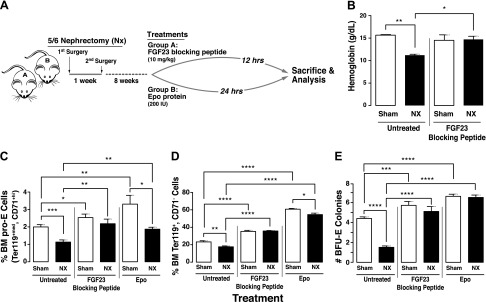Figure 2.
Inhibition of FGF23 signaling rescues erythroid cell populations in mouse model of Nx-induced anemia. A) Experimental design. C57BL/6J mice underwent 2-step 5/6 Nx or sham surgery. Treatment started 8 wk after surgery. Mice were humanely killed 12 h after treatment with FGF23 blocking peptide or 24 h after treatment with Epo. B) Blood hemoglobin levels in sham-treated and 5/6 Nx mice untreated (vehicle-treated) or treated with FGF23 blocking peptide (sham, n = 4; Nx, n = 4). C, D) Flow cytometry analysis of BM cell populations from sham-treated or 5/6 Nx mice that were untreated or treated (with FGF23 blocking peptide or Epo). Percentage of pro-E (C) stained positive for Ter119med and CD71high (sham, n = 9; Nx, n = 7), and terminally differentiated erythroid cells (D) stained positive for Ter119high and negative for CD71 (sham, n = 9; Nx, n = 7). E) Colony-forming assay for erythroid (BFU-E) progenitors (n = 15 for all groups). Cells from each mouse were plated in duplicate, and number of colonies in each plate was counted. Data are represented as means ± sem. *P < 0.05, **P < 0.01, ***P < 0.001, ****P < 0.0001.

